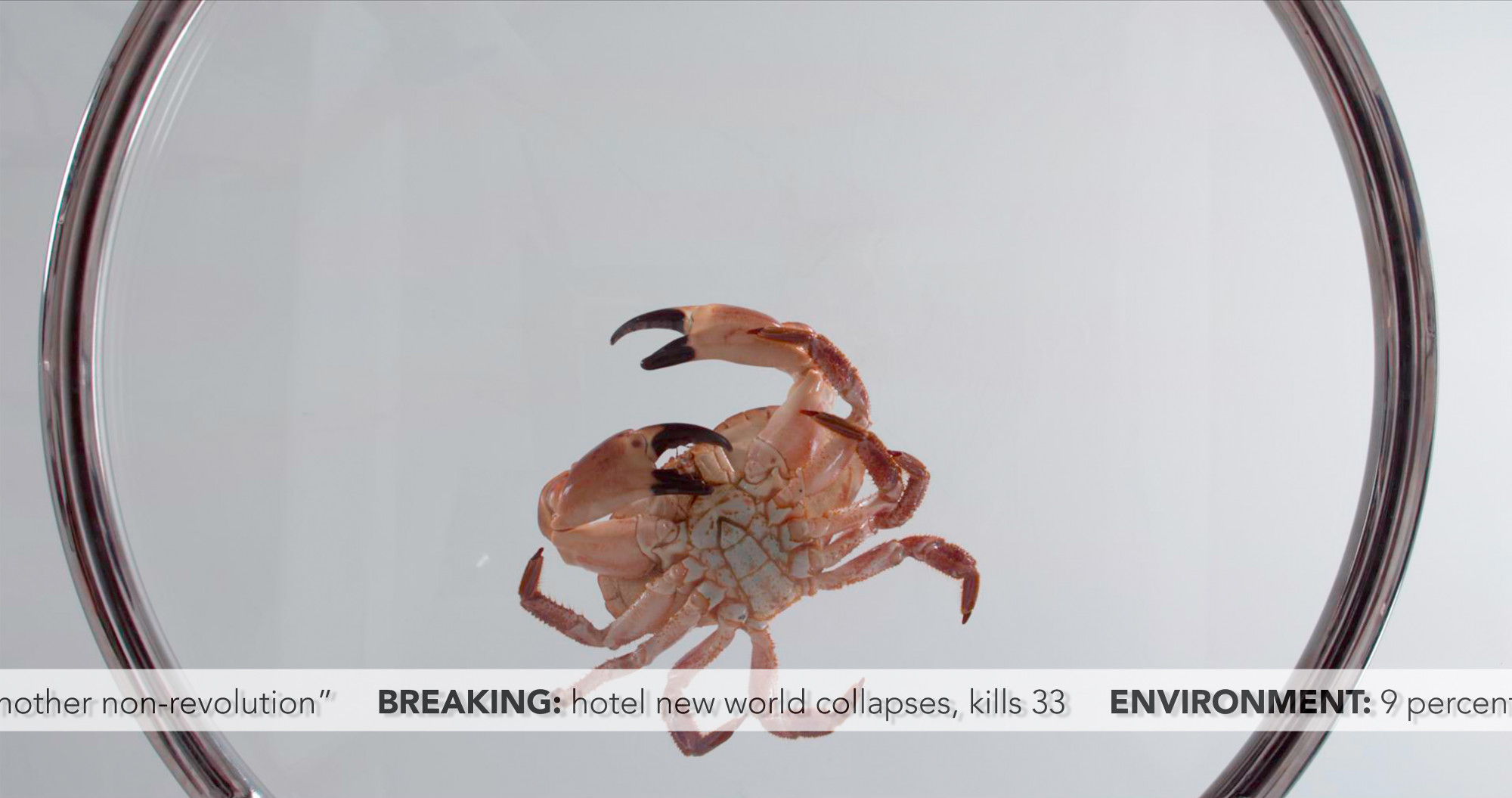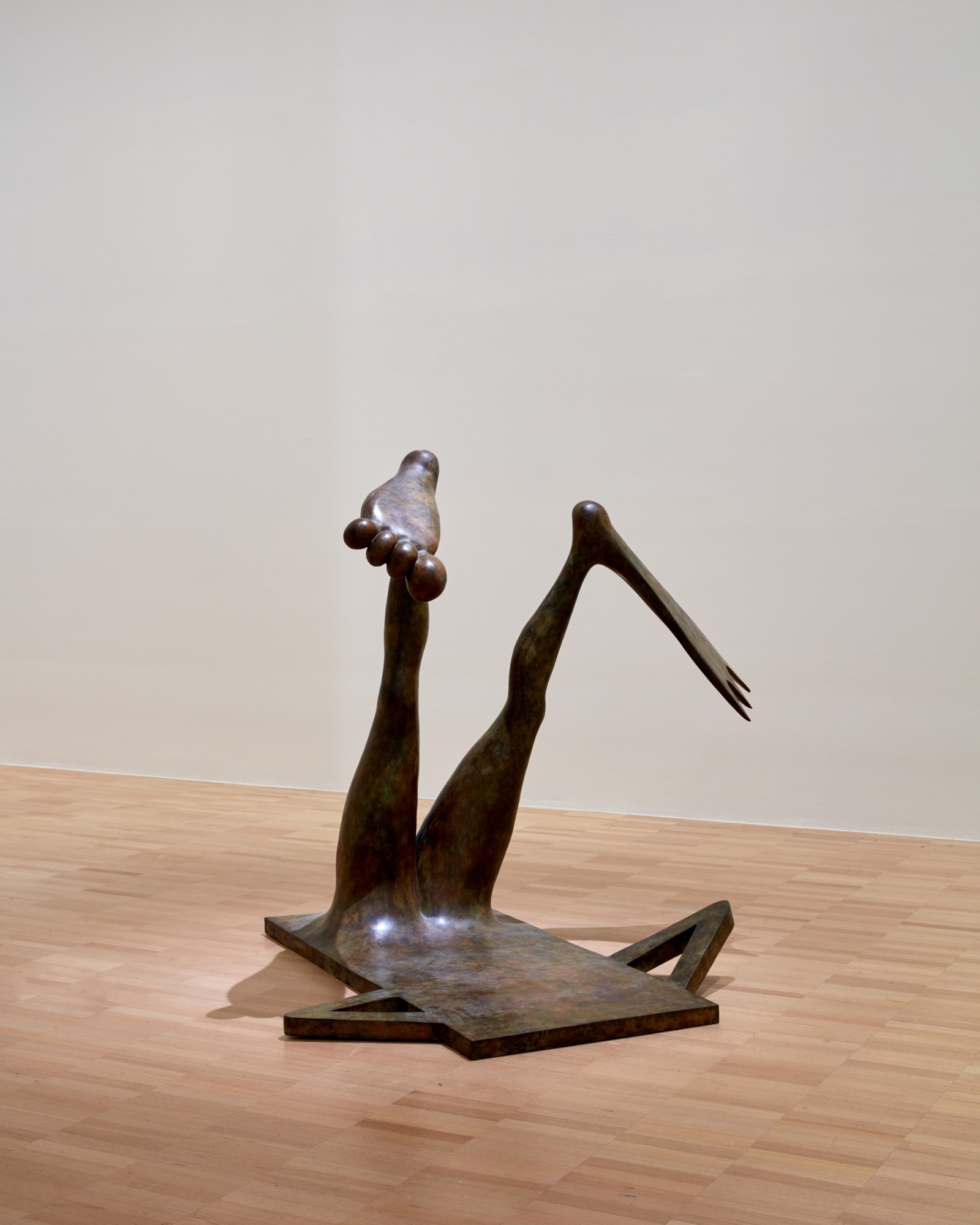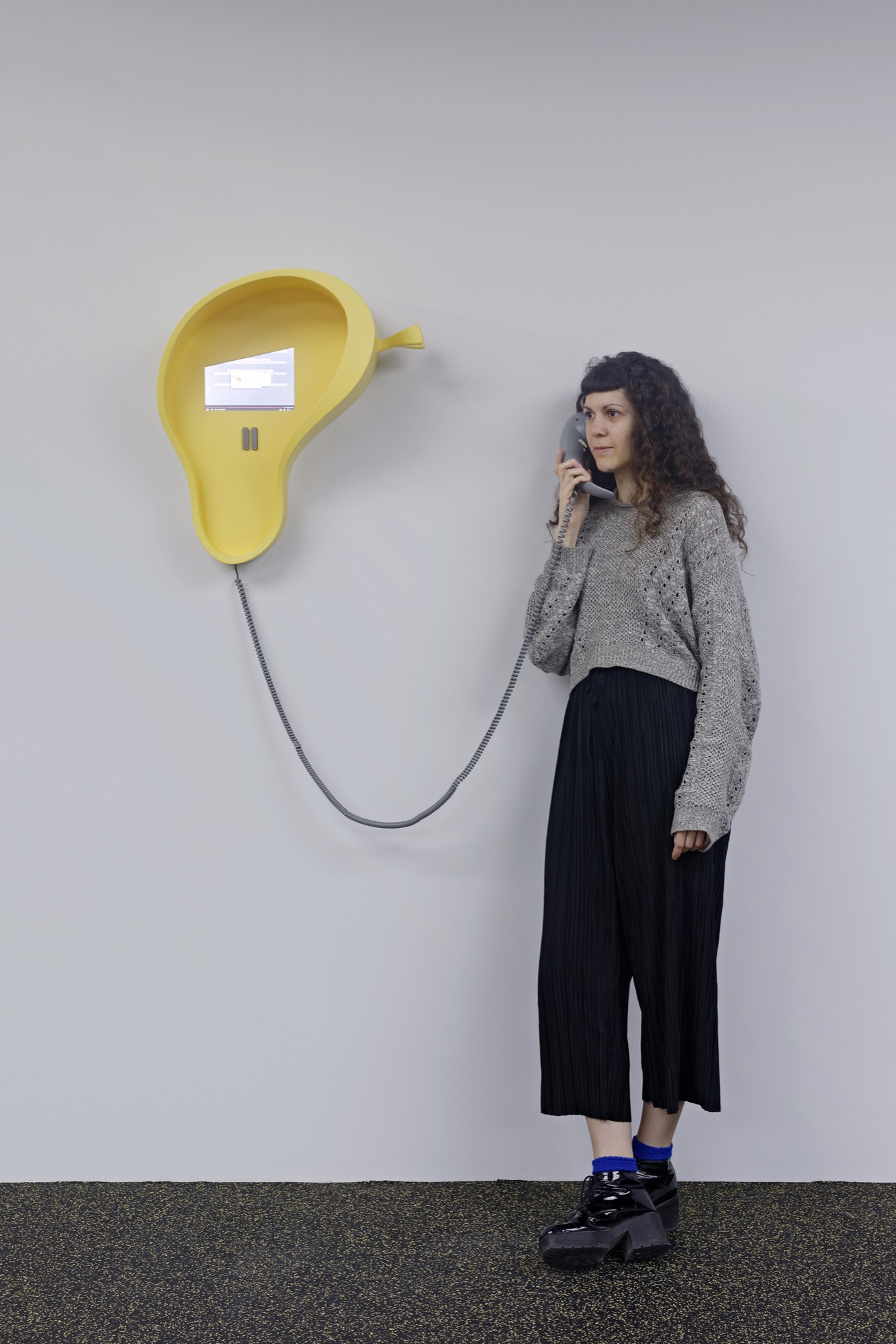Camille Henrot: Is Today Tomorrow
Tara Heffernan
The fifth novel of controversial French author Michel Houellebecq, The Map and the Territory, follows the life and artistic career of fictional artist Jed Martin. After early experiments documenting machinery and Michelin maps, Martin’s artistic impulse turns to capturing social types: artists, businessmen, entrepreneurs and sex workers, among others. He muses:
I have the impression that people resemble one another more than is normally said … I know very well that human beings are the subject of the novel … and one of the great subjects of painting as well, but I can’t help thinking that people are much less different than they generally think.
Obviously, Martin’s musings are a vehicle for Houellebecq’s well-documented opinion that the intense focus on, and belief in, the individual is a stain on contemporary society. For Houellebecq, and for Martin, a person’s character is determined by their class, sex, geographic location, genetics and the products they consume. Nothing deeper. It’s a bleak, but essential breakdown of the dubious faith in autonomy and self-realisation that pervades much contemporary art and culture. The work of fellow French creative Camille Henrot launches a similar investigation, but inverts Houellebecq’s project. Rather than showing the individual as a product of these conditions, her artwork confronts the viewer with a startling collation of objects, images and artifacts—the disorder of contemporary life. It’s not simply a critique of the “too muchness” of the world, but a reflection of the underacknowledged connections and overlaps between ways of thinking and being, between subcultures and religious ideologies, between art, education and advertising, between self-care and advertising, between advertising and systems of control and surveillance.
Curated by Jane Devery and Pip Wallis, Camille Henrot: Is Today Tomorrow is the first major Australian survey of Henrot’s work. The exhibition occupies the maze-like third floor of the National Gallery of Victoria—a configuration surprisingly suited. Described recently in The Saturday Paper as “one of the most compelling creators of her generation” (repeating the NGV’s promotional summary almost verbatim), Henrot’s oeuvre has spanned film, drawing, sculpture and installation. Though we might wonder if such an ambitious traversing of mediums isn’t in fact the expectation of most contemporary artists rather than the exception, the French artist’s success in these endeavours is consistent and demonstrates a surprising conceptual coherence.

Two of the most significant works in the exhibition, the full-room installation The Pale Fox (2014) and video work Saturday (2017), occupy the furthest caverns of the third floor. The former resembles a plush carpeted amalgamation of a childhood bedroom, home office and fantastical storage unit set against a striking blue backdrop. Filled with books on nature and science, assorted photographs, ethnographic and abstract sculptures, drawings and other detritus of a curious life, the installation is oriented around four stages of maturation: childhood, adolescence, adulthood and old age. A composition by French electronic musician Joakim accompanies, consisting of ambient sounds punctuated by coughing fits. Saturday displays recordings of the baptismal ceremonies of the Seventh day Adventist Church intercut with shots of cosmetic procedures, food infomercials, protests and endoscopic exams. A news ticker snakes across the lower screen, telling jumbled tales of tragedies and political unrest in the homogenising, hypnotising ribbon. Referencing the philosopher Ernst Bloch, Henrot situates the work as an exploration of “‘the principle of hope’, which structures our aspirations for immediate, private utopias and radical change.” Though it has a less overt religious focus, The Pale Fox explores similar practices of consumption and media-driven aspiration, strewn with the building blocks of self-improvement, education, entertainment and identity.

Purchased, NGV Supporters of Contemporary Art, 2019. Courtesy of Metro Pictures
Both The Pale Fox and Saturday evoke domestic, private spaces, highlighting how the outside world enters the home through advertising, news, books, magazines and the like. However, the reference to television in Saturday as a culture and medium (evident in the use of infomercials and the news ticker) feels dated. Henrot has explored the more contemporary news and information source, the computer screen, in an earlier film, which is not included in this exhibition. Grosse Fatigue (2013), which received the prestigious Silver Lion award at the 55th Venice Biennale, bombarded the viewer with pop ups, scrolling wiki pages, flickering jpegs and personal videos fluttering across the screen with great speed. It speaks to the overwhelming access to information, infinite choice, fractured attention and the user-guided experience of post-internet life. In comparison, Saturday speaks more to what Raymond Williams called “culture flow” in the 1970s: the curated stream of content that flows through broadcast television.
I feel a heaviness around these artworks. The collated footage in Saturday reminds me of VHS tapes and late night TV of the Y2K era. The magazines and science books in The Pale Fox look dated, their fonts don’t look quite right and the photographs seem flat and dull. Despite the observable contrivance of art mess, it feels like being in a disused back room with out-of-date calendars, abandoned textbooks, broken TVs and miscellaneous phone cords. It is discarded life, objects of importance that have been shed. Are they objects that were loved, that educated, or changed lives? Or are they the evidence of accumulated failures and lost passions? The coughing soundtrack heightens this feeling of unease.
In Mariam Rahmani’s response to Henrot’s exhibition Days Are Dogs at Palais de Tokyo in 2017-18, published in the LA Review of Books, Henrot was accused of cultural appropriation and “digital blackface.” The accusation was levelled at the use of ethnographic imagery throughout Grosse Fatigue and her collaboration with artist Akwetey John Orraca-Tetteh (who provided the voiceover, an emotive reading of a poem by Henrot and American poet Jacob Bromberg). The inclusion of a black masculine voice, Rahmani argues, lends the artist’s words an air of authenticity and authority while cloaking the inherent “whiteness” of the project. She ponders, “evidently such ‘truths’ spoken by a white woman would not be believable,” adding, “why not, if they’re truths worth telling?” So, why not? It’s an important question. To my mind, the answer is obvious. Voices—like other markers of origin, class, character, culture, as well as production and intent—carry great significance in Henrot’s oeuvre. The artform of spoken word poetry has its own connotations and role within cultural production and meaning making. Its lineage is usually traced back to the poets of the Harlem Renaissance and the Beat generation, though the energy of the Civil Rights Movement is also acknowledged. As a form that privileges oral histories and collective action, it played an important role for marginalised communities during the tumultuous changes of the last half century. However, by the 2000s (particularly the 2010s), spoken word was thoroughly absorbed by mainstream media. With its directness and its parasocial appeal, it had viral potential, quickly becoming the TED Talk of contemporary creative forms. That seductive drive to Dionysian collective experience pulls together a chaotic mosaic in Grosse Fatigue, imbuing it with a strained sense of harmony. What distinguishes the work from The Pale Fox, made a year later and considered an extension of Grosse Fatigue, is its energetic nowness and confidence. However, the poetry style, the score, the computer interface, the scientific information and the video quality will all date (has it already?), turning the artwork into another curios object of the past. Though The Pale Fox collates similar cultural detritus (albeit in physical form), it instead suggests a sombre resignation to the inevitable march toward obsolescence.

Speaking to a different kind of nostalgia, an endearing meeting of minimalist form and kitsch media emerges in Contrology (2016), which occupies the shiny floor of main gallery space. From a heavy horizontal oblong base, skinny legs extend into the air with oversized Looney Tunes feet bent at harsh acute angles. It plays with space, proportion and balance in ways similar to minimalist sculptures but re-injects human(-like) forms. As Quentin Sprague noted in The Monthly, the oblong torso resembles an upscaled iPhone or perhaps a yoga mat. (A clue: contrology is another name for Pilates.) Though it’s more subdued and sinister, the cartoon legs/sports mat hybrid possess a little of the kitsch cutesiness of Jeff Koons’ giant puppies and kittens. The sculpture strikes me as a nod to the current ubiquity of cute and nostalgic media merged with the pervasive influence of the shapes and motifs of designer tech. Similar forms manifest in The Pale Fox, in modernist sculptural objects and funky furniture of that futuristic style that always looks dated, but never lacks appeal.

Exhibited alongside Henrot’s bronze sculptures are a series of works on paper. Systems of Attachment (2019) embraces the fluidity of the medium of watercolour painting. Quoted in the exhibition text, Henrot explains the impetus behind these works as illuminating “the creative potential of loss: loss of body fluids, loss of shape, loss of agency, loss of identity, loss of control.” This is perhaps most pertinent in I am both Saturn’s Child and Saturn Himself (2019). A picture of a mother and child, the work offers a sobering reflection on the terror and intensity of motherhood: the robbing of identity and any illusion of autonomy that comes with it. Fluids come together as they do in the bathtub pictured. The merging of sweat, tears, urine, blood and shit speaks to birth and the abject connection between the mother and the child. In an interview with curator Pip Wallis, Henrot explains that this fluidity and “splashiness” has interested her for a long time, particularly after studying the Japanese Gutai movement. (Grosse Fatigue also features an iconic photograph by Hans Namuth, which shows the American abstract expressionist Jackson Pollock creating a drip painting). These are the most messy and organic images in the show and the only ones that capture what we used to expect of art—an abstracted representation of experience conveyed through marks on a flat surface.

Further evidencing an investment with outmoded designs and voices are Henrot’s Interphones (2015), a series of custom telephone sculptures. Mostly wall-mounted, the phones are presented in the first oval gallery space on level three of the NGV, spaced out in the sterile room as though offering privacy for personal calls or displaying designer products. Like children’s play phones, each is accompanied by a voice-over that emulates an automated telephone service. The hotlines initially appear to address banal topics: advice about cheating partners, badly behaving pets or poor internet connection. Predictably, things get out of hand fast. In Dawg Shaming (2015), questions about an aggressive dog soon turn into something else. The prompts inquire about his porn habits, his domestic responsibilities, his infidelity. It’s a humorous equation of domestic complaints. After all, “dog” is a term you might use to refer to a bad boyfriend or to denigrate an unattractive woman. Though dogs hold a significant place in art and literature, their role in contemporary domestic life is particularly noteworthy, something that has been acknowledged by other artists and writers. For example, in Rachel Cusk’s trilogy Outline, dogs are often the catalyst of bourgeois disturbances or the object of jealousy and frustration (memorably demonstrated by one character who mercilessly beats her dog, though it has already been poisoned with chocolate).
Henrot knows that dogs have long been understood to be the perfect companion. This attribute has led them to replace babies or romantic partners, resulting in the emergence of complex and frightening relationships of co-dependence. It’s common now to speak of fur babies and dog mums/dads. More tediously, many young people aren’t ashamed to share their preference for animals over people and even mock the idea of having children over pets. Family is for boring, conservative normies who don’t care about climate change, not fun, young cosmopolitan consumers. As Houellebecq noted in a 2016 interview, “a dog is like a child, but a child that doesn’t grow.” Indeed, a dog can’t achieve personhood or independence (no matter how many human attributes the owner interprets or imagines, or rights they wish to assign to the animal). Unlike children, dogs can be abused, neglected or smothered at the owner’s discretion with little risk of legal intervention. A play family, free of the trying responsibilities and self-sacrifice that real family life entails. Harmonious with sex tourism, pornography and take-out as it is depicted in Houellebecq’s work, it is another relationship of convenience and indulgence, chosen perhaps at the cost of more meaningful relationships or to compensate for their impossibility against the conditions of contemporary life.
Despite their retro design Interphones speak to the contemporary threat of what American scholar Shoshana Zuboff calls surveillance capitalism. The automated voices request your credit card details, ask about your sexual health and dating history. Things get more ominous, “Is Google right about you?”, and more bizarre, “if your father kills your sister to change the weather forecast and deleted files without your permission, press one.” (I’m reminded of the strange suggestions that often appear in the “People also ask” section in Google search). Discussing the works in a recent interview, Henrot explained:
Most of them have different sets of problems, but the common dynamic is the same—it’s exploring how a service is also always paid through a certain kind of loss, and of course, this loss is your own pride and intimacy.
This is perfectly in line with the concerns Zuboff outlines in The Age of Surveillance Capitalism: The Fight for a Human Future at the New Frontier of Power. Our reliance on digital platforms and smart technologies means we are constantly inadvertently providing behavioural data to big companies—we are training facial recognition software, disclosing our sleep patterns, health data, medical information, sexual preferences and social networks. With increasing reliance on sensors, invasive software, home devices and cloud platforms in domestic, social and work settings, there’s little chance of opting out. Is Google right about you? Yes, of course.

Though some are more cartoonish, the Interphones emulate the nostalgic features of bulky landline telephones of the 1980s and 1990s with their big flat keypads and thick spiralled cords. Henrot was a child in the 1980s. It was the era of the AIDS crisis and the dawn of neoliberalism. The term “yuppie” emerged to describe successful young urban professionals who embraced extreme fashion and club scenes. Dating hotlines and self-help services were thriving. However, as Houellebecq laments in Atomised, the last decades of the twentieth century were also populated by the aging proponents of the sexual revolution and youth culture boom of the 1960s and 1970s. Though we should all know by now, the problem with youth culture is that you age out, regardless of how passionately you immerse yourself in its excesses and its continually renewed products and ideals. And then what? As Houellebecq highlights, the boom in self-help rhetoric, New Age spiritualism and rising individualism in this period is largely accounted for by a search for meaning beyond science and religion—a void also addressed by the quasi-mystic entrepreneurs of Silicon Valley. The bridge between the 1980s designs of Interphones and our contemporary post-internet age is found in this confluence of events.
Due to Victoria’s COVID-19 lockdown, Is Today Tomorrow has been behind closed doors for months. Though originally scheduled to end in October, the exhibition has been extended until January 2022. So, is today tomorrow? No, but we will continue to hope and dread that it is.
Tara Heffernan is a PhD candidate (Art History) at the University of Melbourne. Her thesis concerns the work of post-war Italian artist Piero Manzoni.


